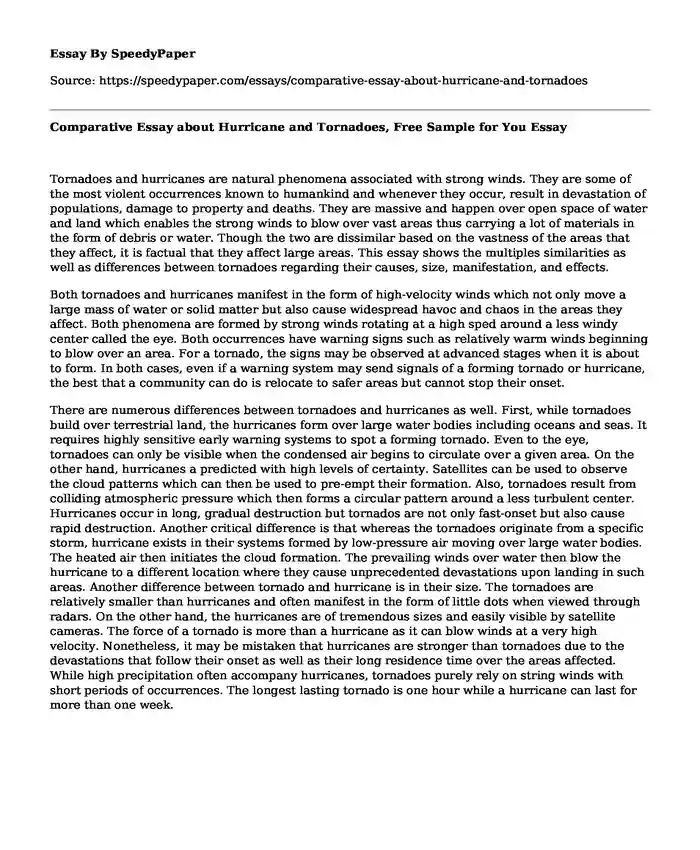Tornadoes and hurricanes are natural phenomena associated with strong winds. They are some of the most violent occurrences known to humankind and whenever they occur, result in devastation of populations, damage to property and deaths. They are massive and happen over open space of water and land which enables the strong winds to blow over vast areas thus carrying a lot of materials in the form of debris or water. Though the two are dissimilar based on the vastness of the areas that they affect, it is factual that they affect large areas. This essay shows the multiples similarities as well as differences between tornadoes regarding their causes, size, manifestation, and effects.
Both tornadoes and hurricanes manifest in the form of high-velocity winds which not only move a large mass of water or solid matter but also cause widespread havoc and chaos in the areas they affect. Both phenomena are formed by strong winds rotating at a high sped around a less windy center called the eye. Both occurrences have warning signs such as relatively warm winds beginning to blow over an area. For a tornado, the signs may be observed at advanced stages when it is about to form. In both cases, even if a warning system may send signals of a forming tornado or hurricane, the best that a community can do is relocate to safer areas but cannot stop their onset.
There are numerous differences between tornadoes and hurricanes as well. First, while tornadoes build over terrestrial land, the hurricanes form over large water bodies including oceans and seas. It requires highly sensitive early warning systems to spot a forming tornado. Even to the eye, tornadoes can only be visible when the condensed air begins to circulate over a given area. On the other hand, hurricanes a predicted with high levels of certainty. Satellites can be used to observe the cloud patterns which can then be used to pre-empt their formation. Also, tornadoes result from colliding atmospheric pressure which then forms a circular pattern around a less turbulent center. Hurricanes occur in long, gradual destruction but tornados are not only fast-onset but also cause rapid destruction. Another critical difference is that whereas the tornadoes originate from a specific storm, hurricane exists in their systems formed by low-pressure air moving over large water bodies. The heated air then initiates the cloud formation. The prevailing winds over water then blow the hurricane to a different location where they cause unprecedented devastations upon landing in such areas. Another difference between tornado and hurricane is in their size. The tornadoes are relatively smaller than hurricanes and often manifest in the form of little dots when viewed through radars. On the other hand, the hurricanes are of tremendous sizes and easily visible by satellite cameras. The force of a tornado is more than a hurricane as it can blow winds at a very high velocity. Nonetheless, it may be mistaken that hurricanes are stronger than tornadoes due to the devastations that follow their onset as well as their long residence time over the areas affected. While high precipitation often accompany hurricanes, tornadoes purely rely on string winds with short periods of occurrences. The longest lasting tornado is one hour while a hurricane can last for more than one week.
Cite this page
Comparative Essay about Hurricane and Tornadoes, Free Sample for You. (2022, Sep 16). Retrieved from https://speedypaper.com/essays/comparative-essay-about-hurricane-and-tornadoes
Request Removal
If you are the original author of this essay and no longer wish to have it published on the SpeedyPaper website, please click below to request its removal:
- Free Essay Sample on Shorter Working Hours
- Environment Essay Example: Acid Rain and the Effects on Fish and Water Quality
- Why the Diary of Madman is a Fiction, Literary Essay Sample
- Provision of Sufficient Water without Conflict
- Free Paper on APA's General Principles of Ethics and Ethical Dilemmas
- Westchester County Department
- Paper Example on Existential Psychology and Logotherapy
Popular categories





